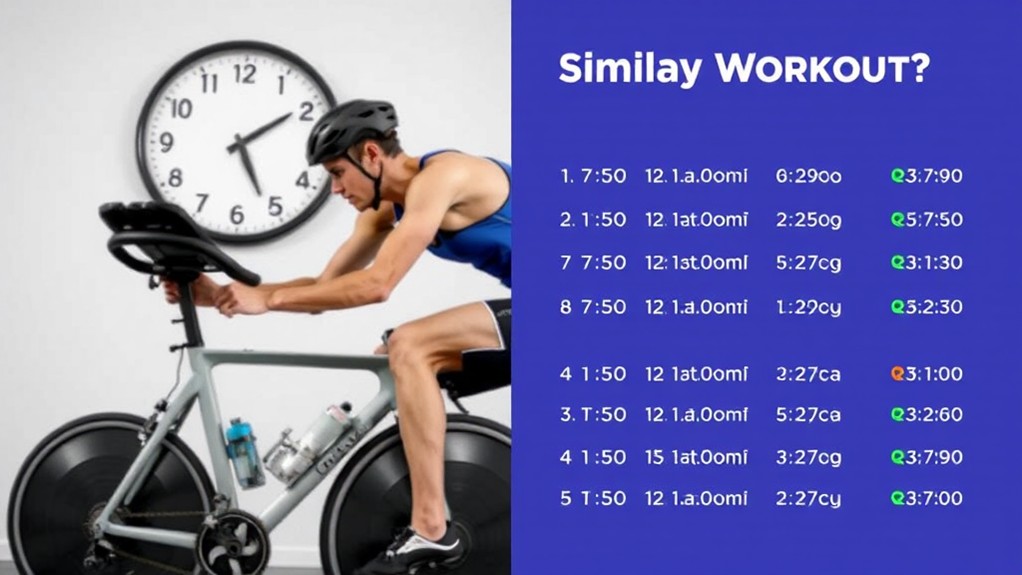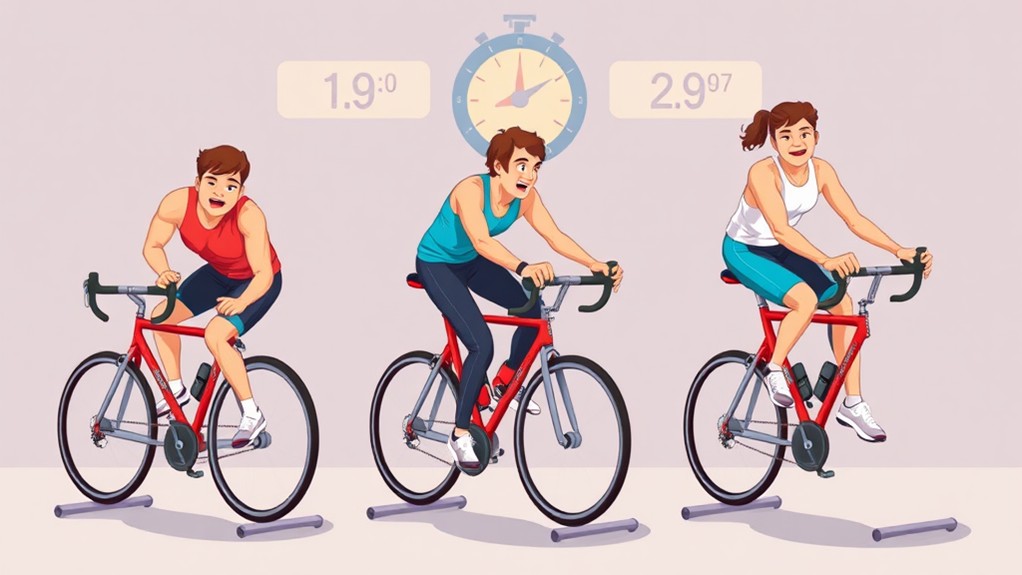You can structure your turbo training sessions to achieve specific goals by varying their length, from 30 minutes for beginners to over an hour for more experienced cyclists. Start with shorter sessions and gradually increase the duration by 10-15 minutes weekly to build endurance. For a general workout, aim for 30-60 minutes with a mix of high and low-intensity intervals. Consider your fitness level too – beginners should start with 30-45 minute sessions, while intermediate and advanced cyclists can push for 60-90 minutes or even up to 120 minutes, focusing on high-intensity intervals to enhance their training efficiency and reveal further progress.
Benefits of Turbo Training
Maximize Your Performance
Turbo training sessions allow you to focus on specific performance areas through targeted intervals and consistent training plans. This structured approach boosts your strength and endurance, helping you achieve your cycling goals.
Utilizing power meters during your turbo sessions provides accurate performance metrics, enabling you to track your progress and adjust your training intensity accordingly.
Year-Round Fitness
Turbo trainers promote cardiovascular fitness through structured intervals, making them an ideal choice for cyclists looking to improve their overall performance year-round.
Choosing the Right Session
To pick the right session, think about what you want to achieve. If you're a beginner, start with shorter sessions and gradually increase the duration as your fitness improves. For example, you can begin with 30-minute sessions and add 10-15 minutes each week.
When selecting a session, consider the following:
- Endurance rides: 60-90 minutes at moderate intensity
- Interval training: 30-60 minutes, alternating between high and low intensity
- Hill repeats: 30-60 minutes, focusing on high-intensity climbs
Structuring Your Workout

Workout Segments
Breaking down your workout into segments of 10 or 20 minutes will improve your concentration and make longer rides feel less daunting.
You can have a mix of high-intensity and low-intensity segments to create a balanced workout. For example, you can alternate between 10 minutes of high-intensity interval training and 10 minutes of low-intensity spinning. This will help you stay focused and avoid mental fatigue.
Cool Down
Don't forget to include a cool-down segment at the end of your workout.
Post-workout leg spinning for about 10 minutes can help reduce Delayed Onset Muscle Soreness (DOMS) and promote recovery.
Managing Session Duration
Breaking your workouts into manageable segments can improve focus and motivation. Try dividing your sessions into 10 or 20-minute intervals to make them feel less daunting.
For longer workouts, take short breaks of up to 2 minutes to use the bathroom, refill your water bottle, and maintain consistent energy levels.
To build endurance, gradually increase your session duration over time. This allows your body and mind to acclimate to longer efforts.
Incorporate duration variety into your workouts by mixing short, high-intensity sessions with longer, lower-intensity ones. This will help you maintain a consistent level of progression and prevent plateaus.
Adapting to Fitness Levels

When creating a turbo training program tailored to your fitness level, start with session lengths that challenge you without overwhelming your body. As you progress, you can make beginner adaptations or advanced modifications to continue pushing yourself.
For a structured approach, consider the following guidelines:
- Beginner: 30-45 minute sessions with ample warm-up and cool-down periods to prevent injury and aid recovery
- Intermediate: 60-90 minute sessions incorporating structured intervals to improve performance without overwhelming the body
- Advanced: up to 120 minute sessions focusing on high-intensity intervals or endurance-building efforts to push your limits
As you adapt to your fitness level, remember to monitor your Rate of Perceived Exertion (RPE) during sessions. This guarantees your workouts remain challenging yet manageable according to your individual fitness level.
Gradually increase session duration by 10-15 minutes per week, allowing your body to adapt and build endurance effectively. By tailoring your turbo training sessions to your fitness level, you'll be able to optimize your performance and achieve your goals.
Maximizing Training Efficiency
Incorporating a variety of structured workouts into your turbo training program can additionally improve training efficiency and effectiveness.
Workout variety is essential, as it prevents boredom and mental fatigue. To get started, consider the following:
- Begin with a 10-15 minute warm-up period to minimize the risk of injury and optimize performance.
- Break up longer workouts into shorter intervals with 2-minute breaks in between for hydration and rest.
- Mix up your workouts to avoid plateaus and prevent overtraining.
Frequently Asked Questions
How Long Should a Training Session Be?
When planning a session, you'll want to balance session duration and training intensity. Aim for sessions under 1.5 hours, with higher intensity workouts lasting 45-60 minutes and lower intensity ones lasting 60-90 minutes, adjusting as needed.
How Long Should a Speed Training Session Last?
When planning your speed training session, you'll typically want it to last 30-60 minutes, incorporating interval training and recovery periods for optimal results, allowing for a balance of intense efforts and adequate rest time.
Can You Get Fit on a Turbo Trainer?
You can get fit on a turbo trainer by leveraging its numerous fitness benefits, adjusting workout intensity to suit your goals, and incorporating training variety to keep your sessions engaging and effective.
How to Use a Turbo Trainer Effectively?
To use a turbo trainer effectively, you'll set up interval training with varying resistance settings to challenge yourself. Start with short sessions, focusing on proper bike fit and engaging content to maintain mental focus and motivation.
